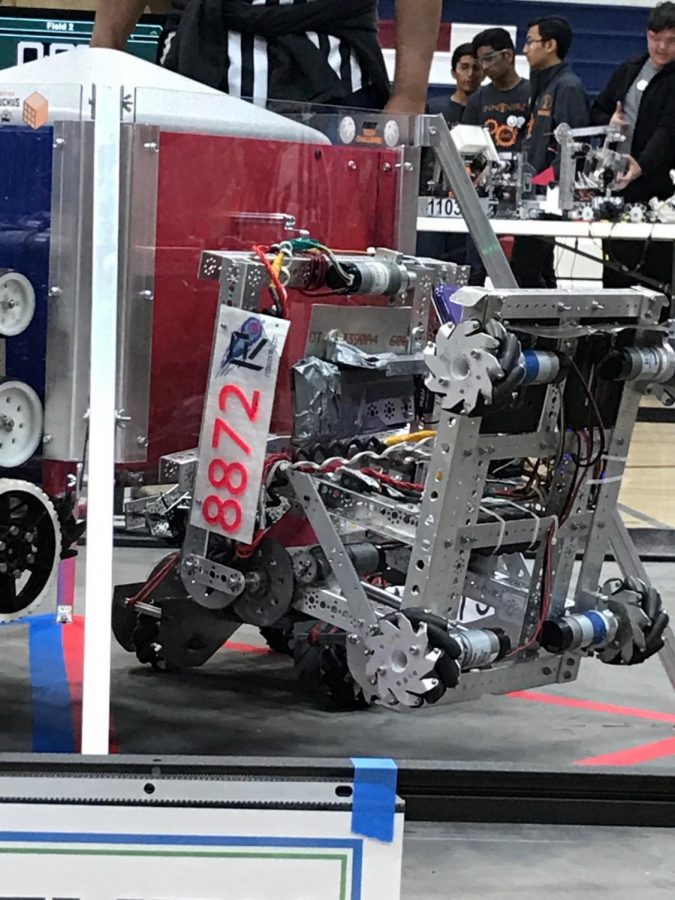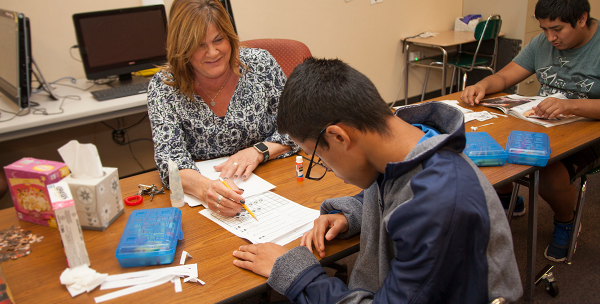The Road To Robopocalypse
The robot’s pull-up mechanism in action.
The Wilcox robotics team, Robopocalypse, narrowly eked out a third place win at Saratoga High School’s robotics tournament on November 18. Causes for this near-loss ranged from problems with motors to just generally bad luck.
One of the most glaring problems had to do with one of the motors. According to Amanuddin “Aman” Syed, the team’s hardware lead, a cable management issue caused one of the cables to disconnect from a key servo motor, which led to a key mechanism on the robot to stop functioning. “One of the servo wires was strained,” he explains. Syed also mentioned that this problem had occurred throughout their practices and the tournament. Instead of smoothly flipping down onto the ground as it was designed to do, the robot became caught on the hook of the lander and was not able to move for a good portion of the match. If that was not enough, an even bigger, possibly disqualification-worthy problem was brewing. According to the FIRST Tech Challenge Game Manual, every robot must fit within an 18in.x18in.x18in. sizing cube. However, Robopocalypse’s robot was a mere “0.25 inches over,” according to Syed. This disqualification alone would have meant that the robot would have gone to waste. However, Syed says that the team used an angle grinder, managed the space, and was eventually able to participate.
The robotics field is a twelve feet by twelve feet field. In two opposite corners of the field are plastic, marked-off areas called “craters” filled with two inch yellow cubes and white wiffle balls, called “gold and silver elements.” In the center of the field is a large “lander”. Each alliance places the elements on their own side of the lander in order to score points. Each match lasts two minutes and thirty seconds. The first thirty seconds was the autonomous period, where the robot acts without human interference. In this period, a robot can score points by detaching itself from the lander and landing on the field. It was in this autonomous period that the team’s robot failed to disengage from the lander. The following two minutes were the driver-control period, where two drivers control their robot with the assistance of a coach. The coach directs the drivers where to go and what to do. Teams can score points by putting elements from the crater into the lander in the center of the field via some sort of mechanism. The last thirty seconds made up the endgame, where additional points can be scored by the robot attaching to the lander or by driving into the craters. It was here where the team became worried. According to the rules, no robot can be attached to the lander by the endgame. With their robot still hanging on the lander, the driving team took decisive action. Syed explains the events: “‘We ran the motors in reverse, which bent the latch [that was holding the robot up], kind of broke it, and the robot came down to the field. After that, the way the latch bent caused a flex in the chassis, and it couldn’t drive properly. We couldn’t do anything else in the match. We couldn’t go back on the [hook] either because our latch was broken and our whole pull up system was damaged. So what we did was go into the crater, which would give us fifteen points. So we were like ‘park in the crater’ and that was all we did in that whole match.”
Several other minor software problems occurred as well. Syed explains that the aforementioned servo had worked the “whole tournament”, up until the final match. “We were so preoccupied with all the other problems,” he says, “We were having battery issues, software troubles… We completely forgot to check and make sure that this wire was in.” Syed also explains that the mechanism needed to collect the elements, known as the “scooper”, had been worked on for a couple months and in the end was “incompatible, because of sizing and miscommunication with the [rest of the] team.” He goes on to say, “We had to scrap that design and start from scratch. And this is only one or two days before the competition.” In the end, the team made a rudimentary scooper from random materials. “Duct tape and cardboard,” Syed says, “It would give us something to talk about with the judges.” The only reason that the team was able to make it to third place was because their alliance partner in the final matches was the top team. Alonso Diaz, another team member, said that despite the team’s performance, morale was still pretty high. “We went from last to third.” he said. “That’s good enough for us.”











